Page Visit Log : charms_and_magic_in_thailand
» Charms_and_Magic_in_Thailand
Charms and Magic in Thailand
Written by DrBob
I intend this to be the first part of a series on magic and charms in Thailand. If people are interested I'll carry on with the thread.
The first part is, of course, a quick intro to Buddha talismans. Subsequent parts will go into talismans and charms in greater detail, yantras, mantras, sacred plants and trees, and anything else I can think of.
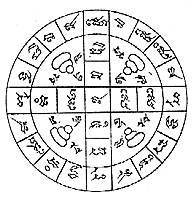
Around the world many believe in the efficacy of charms and amulets, from St Christopher medallions to lucky stones amulets of all types are popular with people from all walks of life.
You don't have to spend long in Thailand to realise that most people here believe in a whole parallel universe of spirits, demons, Gods and Goddesses, a world where good fortune can be earned or bought through the appropriate offerings, rituals, or objects.
Every religion and belief system has its own formulas and cult beliefs which shape the form of these merit-bringing procedures. Generally these procedures are memories of a time before the current mass religion and bring together beliefs from a multitude of faiths. In Thailand the main influences regarding talismans and amulets come from Hinduism, Buddhism, and indigenous belief systems.
It's commonly accepted that there are 4 classes of charms and amulets in Thailand, collectively called Khawng Khlang - meaning objects which are sacred and powerful. Within these 4 classes are a number of sub-classes.
By far the most commonly seen type is of the class known as Phra Kruang, these are the Buddha amulets we see every day.
Generally showing the Buddha in one of his characteristic meditative or teaching postures they are most often worn hanging around the neck or carried in a bag or purse. There is a Thai proverb, "The more the water, the fewer fish will die, the less the water the more will die", this aptly describes the feeling some people have about these amulets and often many of these amulets will be carried or worn at the same time in the belief that their power is cumulative.
There are 4 classes of Phra Kruang, each class defined by the method of manufacture and the materials used;
1) Cast metal figures:

The casting of these images is accompanied by rituals similar to those performed at the casting of large Buddha images. Each school of manufacturers will have it's own, slightly different, version of the rituals involved. Normally these amulets are cast from silver, iron, or a mixture of copper and gold.
2) Clay figures:
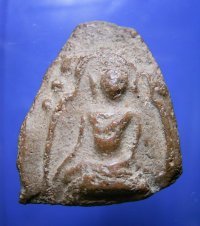
These are highly valued by collectors. They are made from clay and a mixture of flowers, pollens, and powerful medicinal plants called Wan Ya. The precise ingredients are secrets closely kept by the different amulet makers. These amulets often show the fingerprints of the manufacturer.
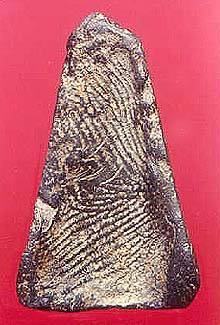
3) Carved figures:

Many trees and plants in Thailand are believed to have magical or healing powers. Often the belief in the magical power of the plant comes from the similarity of the plants name to the name of a powerful spirit or deity. For example, the Star Gooseberry is called mayom in Thai, this is similar to the name of the Hindu God of the underworld, Yama - known as Phra Yom in Thailand. It is also similar to the Thai word for respected or approved of, niyom.
For this reason it is considered a good source of wood for carved figurines. Other favoured woods include the sacred fig tree and teak.
Figures may also be carved from stone or from material of animal origin such as ivory and tigers teeth.
4) Clay tablets:

Tablets of Phra Phim. These are a common form of talisman and usually consist of a clay tablet impressed with an image of the Buddha. As with the clay figures above they may be made of many different ingredients and often contain iron, copper, tin ,gold, or mercury. Again the ingredients vary according to different schools. These amulets were and are made in the tens of thousands and deposited in caves and inside chedis. Originally intended as offerings those older ones discovered inside chedis fetch high prices from collectors. As they are easily manufactured a high proportion of those currently available are fake.
The 5 most valuable and collectible amulets (The Great Grand Five):
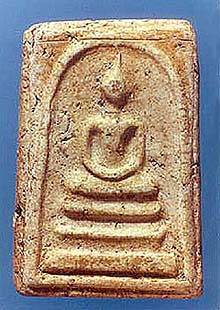
1. Somdej Phra Phutdhacharn(Toh), Wat Rakang, made and blessed by Somdej Wat Rakang between B.E.2400-2413. He died in B.E.2415.
All his Somdej amulets were blessed by himself with ChinnaBanchorn Katha.
Materials for making the Somdejs include: shell lime, Phong Vises (holy powder), assorted flowers from shrines, rice remains after his consumption, lotus, banana, ashes from incense urns, honey, and tang oil. This is a fairly typical mix of ingredients for clay amulets.
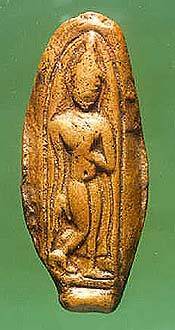
2. Lila Medkhanoon or Soomkor, found in Kampaeng Phet province, age approximately 500 years.
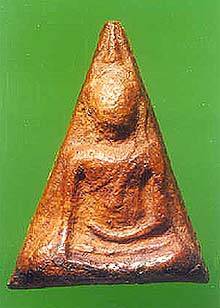
3. NangPhya, found in northern Phitsanulok province, age approximately 400 years.
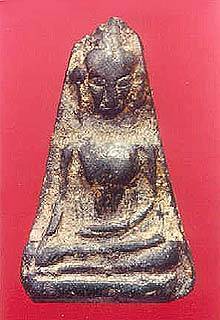
4. Pongsuphan, found in Suphanburi province, age approximately 400 years.
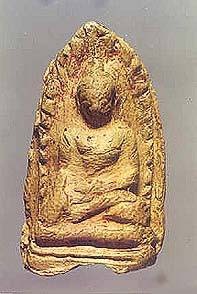
5. PhraRod, found in Lamphun province, age approximately 1,000 years.
Charms and Magic Part 2
Another class of amulets is collectively known as Khruang Pluk-sek. The word pluk-sek means "arousing the potency of an object by means of incantations or spells". This is an extremely large class of amulets and charms and the charmed objects themselves can take many forms.
In Thai a magical spell is called wet-mon or khatha-akhom, these words are used inerchangeably by magical practitioners. The words are synonomous with the Pali and Sanskrit words (in order) Veda, Mantra, Gatha, and Agama.
The Vedas are the sacred scriptures of India and the word Wet means a form of words believed to have magical powers, i.e. a spell.
Mantra in Tai is pronounced Mon and also means spell. The difference between Wet and Mon is that the Wet spells are used in Brahminist rites while Mon spells are a part of popular Buddhism. Normally, however, the terms are used interchangeably.
There is also a type of spell known as Mon Maha Ongkan, the Mantra of the Great Om. This is peculiarly Thai and consists of purely Thai words or Thai words mixed with corrupt Pali words. The words are often obscene or unacceptable in daily use, this perhaps gives them their power when used magically.
When inscribing spells on an object or tattooing spells on the body it is normal practice to use the Khmer writing system although numbers are written in Thai. This is because in ancient times the Buddhist scriptures were inscribed on palm leaves using Khom or Khmer characters. This has given the Khmer characters an aura of sacredness.
To arouse the magical potential of any artificial object other than a Buddha image the object must pass through the processes of Pluk-sek. This involves chanting spells, inscribing magical formulae on the object, or engraving magical squares or circles.
There are an enormous number of objects in this class of which the best known are the following;
1) The Paladkit.
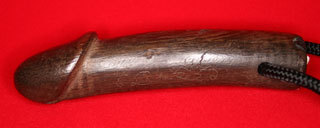
The Paladkit is derived from the Hindu Lingam symbol and also represents the Yang of Chinese thought. They are commonly worn around the waist. They are particularly used as protective symbols for children and in some areas of Thailand young boys may wear a string of them around their waists.

The number on the Paladkit above shows that it won second prize in an amulet competition.
These symbols are also worn in many Mediterranean countries as protection against the evil eye. In the past this symbol, or the female equivalent, was often tattooed on the wrist or thigh, the phallic symbol often having legs or a tail added. The tattooed versions were known as Ai Khik or Ee Pii (Warning! Do not use these terms with Thai people you do not know well, they are highly obscene!)
The modern versions are generally made of wood, horn, or bone. They are made in many forms, some plain, some with a woman or a monkey or lizard holding the Paladkit. They were popularised by Luang Por Yi of Wat Sattaheep, Chonburi and the Paladkit made and blessed by him are highly prized. The method of manufacture is passed down from a Master to his pupils.

Luang Por Yi, Wat Sattaheep (Standing)
2) Mit Mor. The Doctors Knife.

Also known as Mit Prab Pairee, the Knife that conquers the enemy, these knives were made famous by Luang Por Derm of Wat NongPo in Nakhon Sawan. The blade of the knife is made of nails taken from coffins. The handles are made of ivory, wood, or both.

Sizes range from a few inches to nearly 2 feet long. The most expensive, known as Sankasak, are decorated with gold, silver, and copper. The larger knives are generally used by exorcists for the purposes of controlling evil spirits and demons. The knifes magical powers include defeating black magic, giving victories to the owner, and inspiring courage and self confidence.
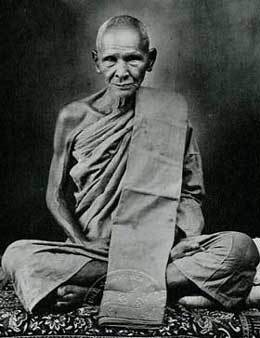
Luang Por Derm of Wat NongPo
3) Bia Gae. The Cowrie Shell.
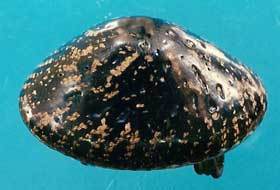
The cowrie shell, having the shape of a shield, is believed to bring protection to the owner. The shell may be painted with lacquer and tied with string. Often Mercury will be placed inside and the gaps sealed with ingredients similar to those used in making Buddha amulets.
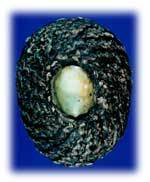
Cowrie shell amulets protect the wearer from ill-luck, demons, evil spirits, and black magic. The shell is often combined with a "Takrut" (discussed in my next post).
4) Rahu Om Chan. The Eater of the Moon.

There is a well-known Chinese story about a heavenly dog swallowing the moon. The Thai version replaces the dog with a demon that would swallow everything. This obviously refers to eclipses, considered bad luck in many cultures.
This talisman must be made from a single-eyed coconut shell. By paying respect to Rahu, either by wearing a Rahu amulet or by placing a Rahu image in the household shrine he will repay you by swallowing any bad luck or evil influences coming your way. The most famous of the Rahu Om Chan talismans are made by Luang Por Noi of Wat Sisathong, Nakhon Pathom.

Luang Por Noi, Wat Sisathong
As Khruang Pluk-Sek are such a large class of objects I'll continue my descriptions in my next post.
Takrut and Salika
Continuing my discussion of Thai Amulets and charms.
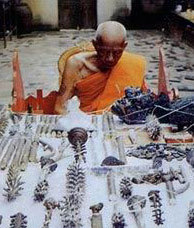
Luang Por Unn chanting over Takrut
The Takrut is an amulet in the sense of conferring magical powers or protections upon the wearer. Normally it is a hollow cylinder of varying lengths and thicknesses but averaging about two inches long and 1/8th of an inch to 1/2 an inch around, depending on the material used.

There are no fixed rules regarding shape or size but the above describes the most common formats.

The materials most commonly used in the manufacture of Takrut are Gold, Red Gold (nak), silver, Copper, Lead, or Tin, cut to the correct size and with the spells inscribed directly on to the metal or on paper which is then wrapped inside the metal covering. As with other amulets the "spells" or formulae of pluk-sek (see earlier postings) differ between schools of teachers.
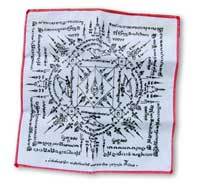
The sheet of metal is then rolled into the shape of a hollow cylinder, sometimes placed within a hollow piece of bamboo, and strung on a gold or silver chain or, sometimes, a cotton cord. The cotton cord is analagous with the "Brahmin Thread" worn by high-caste Hindus. The Takrut is then worn as a necklace, a "sash" over the right shoulder, an armband, or a girdle around the waist. Often more than one Takrut is threaded on the chain or cord.
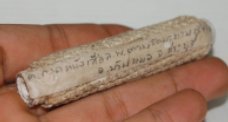
Sometimes the magical figures to be engraved on Takrut are so large that they cannot be inscribed on one piece of metal but have to be spread out over a number of Takruts.
In this case many Takrut are threaded onto a single chain but each Takrut is the same size as the others. They are usually 3, 5, or 7 in number. Sometimes Takruts of different sizes are worn on the same chain and in this case the Takruts are made by different teachers (Thai: Ajarn, from Sanskrit: Acharya).
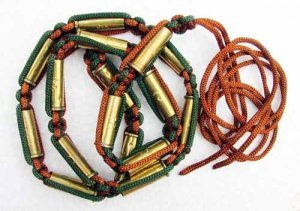
Threaded Takrut made from bullets.
Salika:

This is an extremely small type of Takrut which is normally held in the mouth. The salika gives one the power of "Sweet Talk", the ability to gain the goodwill of others just by talking to them.
The word Salika is a Pali word meaning Mynah Bird, a sweet-talking character in many Thaifolk tales. Some salika can be inserted in the lower lid of the eye to gain goodwill from people who are in sight, in this case the salika takrut is referred to as Takrut Prasom Net, the "Takrut of meeting with the eyes".
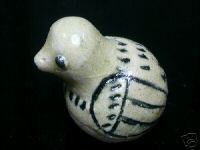
Modern salika look like most other amulets, it is the ingredients and the spells chanted over them which make them different.

Modern salika
Sample Ingredients of modern Salika Takrut.
Dried Jasmine Flower
Dried Rose Flower
Dried Frangipani Flower
Dried Lotus Flower
Dried Lavender Flower
Dried Loly Flower
Dried Betal Leaves
Pounded Betal Nut powder
Ashes of Monks
Old Worn Out or Broken Amulets
Diamond
Emerald
Sticky Rice
Ruby
Bananas
Pounded Sompoy
Black Sesame Seeds
Fragrant Joss Powder
Metta Oil
Holy Ash taken from temples
Black glutinous rice
Sandalwood powder
Pounded Crystals
Cemetery Soil
Phismon:
The Phismon is a talisman made from a leaf of the Talapot Palm inscribed with mystic figures and letters through the Pluk Sek process and woven into a square shape about one inch in diameter.
It is then strung on a silk thread and worn crosswise on the left shoulder.
These talismans were worn at New Year. Due to the overwhelming influence of tourism on Song Kran it is often forgotten that there are/were TWO Thai new year festivals, Trut Thai falling on the last day of the fourth lunar month, and Trut Song Kran, the water-throwing festival. According to "The Royal Monthly Ceremonies of the Year" by HM King Chulalongkorn (Rama V) there was a royal ceremony at Trut Thai when both Buddhist monks and Brahmin priests would give Phismon to people who required protection against evil spirits and the bad luck of the old year. Today only a very few of the older generation remember Trut Thai but on that day they will still wear Phismon and bring offerings to the monks at their local Wat.
Strangely the word Phismon is written in Thai as the word "Bismara" (written Thai and spoken Thai being very different). There is no Pali or Sanskrit equivalent of Bismara but it is very close to the Arabic Muslim word "Bismillah" meaning "The blessings of God" (literally it is a Muslim formula meaning "In the name of Allah, the Compassionate, the Merciful" and is normally said over food at the beginning of a meal).
This could indicate the Malay origin of the Phismon.
Today Phismon are usually decorations worn on threads of Takrut, they have no magical powers and are usually decorative pieces of silver or gold, they are seperated from the Takrut by gold or silver beads known as "Luk skot" meaning seperaters or restrainers.
I've been unable to find any pictures of palm-leaf phismon and it's possible that, as a seperate class of amulets, they no longer exist.
Pha Prachiat:
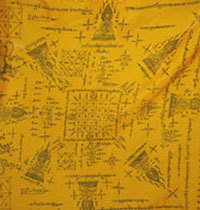
This is a piece of cloth, generally about the size of a large hanky, today they are most often worn as armbands or headbands by
Muay Thai fighters. This is a large subject area and I'll expand on it in a later posting.



